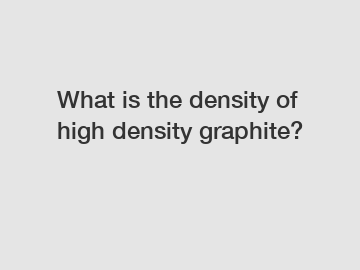What is the density of high density graphite?
Graphite, often associated with pencil lead and industrial applications, is a truly remarkable material with an array of properties that make it highly sought-after. Among its diverse forms, high-density graphite boasts unique characteristics that have captivated scientists and engineers alike. In this blog, we delve into the depths of its density, uncovering the intricacies of this fascinating material.
Discovering the Density:
Density is a fundamental physical property that measures the compactness of a material. Generally, it is defined as the mass per unit volume. To comprehend the density of high-density graphite, one must first understand the basics of graphite structure.

Graphite is composed of carbon atoms arranged in layers, forming a hexagonal lattice. These layers are stacked on top of each other, weakly bonded by van der Waals forces. Exceptional anisotropy arises from this structure, wherein properties differ according to the orientation of the layers. High-density graphite, as the name suggests, possesses a higher density compared to other graphite forms, resulting in intriguing characteristics.
Density and Structure:
The density of high-density graphite ranges between 1.85 to 2.20 grams per cubic centimeter (g/cm³). This variation is primarily due to the density variations within individual layers and the number of layers within the material. High-density graphite features a denser stacking arrangement of layers, leading to an increased mass per unit volume. The exact density further depends on factors such as the manufacturing process, level of impurities, and grain size.
Applications and Industrial Significance:
The unique density of high-density graphite lends itself well to an array of industrial applications. Its ability to withstand high temperatures without exhibiting significant deformation or degradation makes it ideal for crucibles used in metallurgical processes. Furthermore, its high thermal conductivity and stability make it a preferred material for molds and electrodes in the glass and semiconductor industries.
Additionally, the density of high-density graphite plays a crucial role in neutron moderation, which is essential in nuclear reactors. The controlled density ensures optimal neutron reflection and absorption, allowing for efficient energy production while reducing the risk of overheating.
Manufacturing Techniques:
The manufacturing process significantly impacts the density of high-density graphite. Generally, two key methods are employed: isotropic and extruded graphite production.
Isotropic graphite is produced by subjecting fine-grain graphite to high-temperature and high-pressure conditions. This process aligns the graphite particles, improving the density and anisotropy. On the other hand, extruded graphite undergoes a special extrusion process, where a mixture of graphite powder and binders is formed into specific shapes and then heated to remove the binders. This method ensures higher density and mechanical strength.
Exploring Graphite's Future:
The density of high-density graphite holds immense promise for future advancements. Researchers and engineers are continuously exploring ways to enhance its properties to meet the ever-evolving needs of various industries. From improved manufacturing techniques to novel applications, high-density graphite's versatility and high experience create a thriving field of research.
Conclusion:
The density of high-density graphite, ranging from 1.85 to 2.20 g/cm³, sets it apart from other graphite forms and unlocks its potential for diverse applications. Understanding the significance of its unique density and structure is vital to harnessing its immense industrial potential. As further advancements are made in manufacturing processes and material characterization techniques, we can only anticipate more remarkable innovations arising from the alluring world of high-density graphite.
For more information, please visit graphite blocks for blast furnaces, graphite cathode, artificial carbon graphite block price.



Comments
0